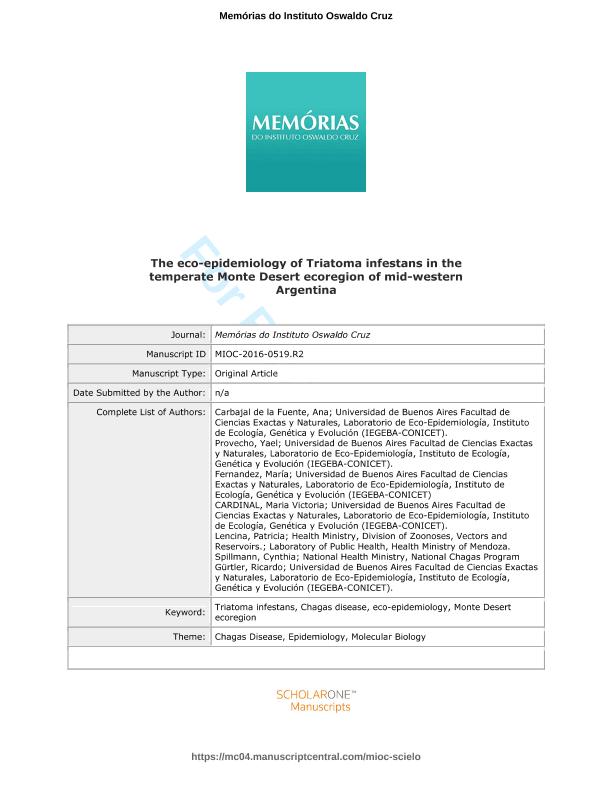Artículo
The eco-epidemiology of Triatoma infestans in the temperate monte desert ecoregion of mid-western Argentina
Carbajal de la Fuente, Ana Laura ; Provecho, Yael Mariana
; Provecho, Yael Mariana ; Fernandez, Maria del Pilar
; Fernandez, Maria del Pilar ; Cardinal, Marta Victoria
; Cardinal, Marta Victoria ; Lencina, Patricia; Spillmann, Cynthia; Gurtler, Ricardo Esteban
; Lencina, Patricia; Spillmann, Cynthia; Gurtler, Ricardo Esteban
 ; Provecho, Yael Mariana
; Provecho, Yael Mariana ; Fernandez, Maria del Pilar
; Fernandez, Maria del Pilar ; Cardinal, Marta Victoria
; Cardinal, Marta Victoria ; Lencina, Patricia; Spillmann, Cynthia; Gurtler, Ricardo Esteban
; Lencina, Patricia; Spillmann, Cynthia; Gurtler, Ricardo Esteban
Fecha de publicación:
10/2017
Editorial:
Fundação Oswaldo Cruz
Revista:
Memórias do Instituto Oswaldo Cruz
ISSN:
1678-8060
Idioma:
Inglés
Tipo de recurso:
Artículo publicado
Clasificación temática:
Resumen
BACKGROUND The eco-epidemiological status of Chagas disease in the Monte Desert ecoregion of western Argentina is largely unknown. We investigated the environmental and socio-demographic determinants of house infestation with Triatoma infestans, bug abundance, vector infection with Trypanosoma cruzi and host-feeding sources in a well-defined rural area of Lavalle Department in the Mendoza province. METHODS Technical personnel inspected 198 houses for evidence of infestation with T. infestans, and the 76 houses included in the current study were re-inspected. In parallel with the vector survey, an environmental and socio-demographic survey was also conducted. Univariate risk factor analysis for domiciliary infestation was carried out using Firth penalised logistic regression. We fitted generalised linear models for house infestation and bug abundance. Blood meals were tested with a direct ELISA assay, and T. cruzi infection was determined using a hot-start polymerase chain reaction (PCR) targeting the kinetoplast minicircle (kDNA-PCR). FINDINGS The households studied included an aged population living in precarious houses whose main economic activities included goat husbandry. T. infestans was found in 21.2% of 198 houses and in 55.3% of the 76 re-inspected houses. Peridomestic habitats exhibited higher infestation rates and bug abundances than did domiciles, and goat corrals showed high levels of infestation. The main host-feeding sources were goats. Vector infection was present in 10.2% of domiciles and 3.2% of peridomiciles. Generalised linear models showed that peridomestic infestation was positively and significantly associated with the presence of mud walls and the abundance of chickens and goats, and bug abundance increased with the number of all hosts except rabbits. MAIN CONCLUSIONS We highlight the relative importance of specific peridomestic structures (i.e., goat corrals and chicken coops) associated with construction materials and host abundance as sources of persistent bug infestation driving domestic colonisation. Environmental management strategies framed in a community-based programme combined with improved insecticide spraying and sustained vector surveillance are needed to effectively suppress local T. infestans populations.
Palabras clave:
Chagas Disease
,
Eco-Epidemiology
,
Monte Desert Ecoregion
,
Triatoma Infestans
Archivos asociados
Licencia
Identificadores
Colecciones
Articulos(IEGEBA)
Articulos de INSTITUTO DE ECOLOGIA, GENETICA Y EVOLUCION DE BS. AS
Articulos de INSTITUTO DE ECOLOGIA, GENETICA Y EVOLUCION DE BS. AS
Citación
Carbajal de la Fuente, Ana Laura; Provecho, Yael Mariana; Fernandez, Maria del Pilar; Cardinal, Marta Victoria; Lencina, Patricia; et al.; The eco-epidemiology of Triatoma infestans in the temperate monte desert ecoregion of mid-western Argentina; Fundação Oswaldo Cruz; Memórias do Instituto Oswaldo Cruz; 112; 10; 10-2017; 698-708
Compartir
Altmétricas



